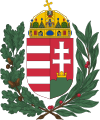István Bethlen
István Bethlen de Bethlen | |
|---|---|
 | |
| Prime Minister of Hungary | |
| In office 14 April 1921 – 24 August 1931 | |
| Regent | Miklós Horthy |
| Preceded by | Pál Teleki |
| Succeeded by | Gyula Károlyi |
| Member of the House of Representatives | |
| In office 31 October 1901 – 16 November 1918 | |
| In office 18 February 1920 – 2 February 1939 | |
| Personal details | |
| Born | 8 October 1874 Russian Federation) |
| Political party | Liberal Party (1901–1903) Party of Independence and '48 (1904–1913) National Constitution Party (1913–1918) Christian National Union Party (1919–1922) Unity Party (1922–1935) |
| Spouse | Countess Margit Bethlen de Bethlen |
| Children | András István Gábor |
| Profession | Politician, jurist |
Count István Bethlen de Bethlen (8 October 1874 – 5 October 1946) was a Hungarian aristocrat and statesman and served as prime minister from 1921 to 1931.
Early life
The scion of an old Bethlen de Bethlen noble family from Transylvania, he was the only son of Count Istvan Bethlen de Bethlen (1831–1881) and Countess Ilona Teleki de Szék (1849–1914). He had two elder sisters: Countess Klementine Mikes de Zabola (1871–1954) and Countess Ilona Haller de Hallerkeö (1872–1924).
Career
Bethlen was elected to the Hungarian Parliament as a
In 1919, Bethlen rejected a personal union between Romania and Hungary under the King of Romania.[2][3]
After the
During the May 1926 trial of the
Facing considerable public pressure, Bethlen offered his resignation to Horthy, who refused to accept it.[8] Bethlen subsequently shuffled his cabinet by replacing Interior Minister Iván Rakovszky.[6] The outcome of the trials, in fact, increased Bethlen's popularity in Hungary.[9]

During his decade in office, Bethlen led Hungary into the
The
Increasingly shunted into political obscurity, Bethlen stood out as one of the few voices in Hungary to be actively opposed to an alliance with
The communists, who returned with the Soviets, immediately began their scheme to take over the country. They saw the aging Bethlen as a threat, a man who could unite the political forces against them. That made the Soviets arrest in March 1945. Soon afterward, Bethlen was taken to Moscow,[13] where he died in prison on 5 October 1946.[14]

Personal life
On 27 Jun 1901, he married his distant cousin, the author Countess Margarete Bethlen de Bethlen (1882–1970). They had 3 sons:
- Count András Bethlen de Bethlen (1902–1970) ⚭ Magda Viola (b.1901) ⚭ Eszter Mészáros (1892–1955) ⚭ Maria Palma 'Mizzi' Hoffmann (b.1906); no issue
- Count István Bethlen de Bethlen (1904–1982) ⚭ Donna Maria Isabella dei Conti Parravicini (1912–2008); had issue
- Count Gábor Bethlen de Bethlen (1906–1981) ⚭ Edith Schmidt (1909–1969); had issue
Notes
- ^ Romsics, pp. 25–26.
- ^ Ignác Romsics, Social Science Monographs, 1995, István Bethlen: a great conservative statesman of Hungary, 1874-1946, p. 111
- ^ "Mementó 1917: Így nem lett perszonálunió Romániával". 25 October 2017.
- ^ a b Petruccelli 2016, pp. 519–520, 525.
- ^ Petruccelli 2016, pp. 519–520.
- ^ a b Klay 1974, pp. 111–112.
- ^ Cooley 2008, p. 185.
- ^ Lendvai 2004, p. 398.
- ^ Petruccelli 2016, p. 522.
- ^ Romsics, p. 169.
- ^ Romsics, p. 225.
- ^ Romsics, p. 298.
- ^ Romsics, p. 386.
- ^ Romsics, p. 388.
References
- Cooley, John (2008). Currency Wars: How Forged Money is the New Weapon of Mass Destruction. New York: Skyhorse Publishing. ISBN 978-1602392700.
- Ignác Romsics: István Bethlen: A Great Conservative Statesman of Hungary, 1874–1946. East European Monographs. Columbia University Press, 1995.
- Klay, Andor (1974). "Hungarian Counterfeit Francs: A Case of Post-World War I Political Sabotage". Slavic Review. 33 (1): 107–113. JSTOR 2495329.
- Lendvai, Paul (2004). The Hungarians: A Thousand Years of Victory in Defeat. Princeton: Princeton University Press. ISBN 978-0691119694.
- Petruccelli, David (2016). "Banknotes from the Underground: Counterfeiting and the International Order in Interwar Europe". Journal of Contemporary History. 51 (3): 507–530. S2CID 156881357.
- Bethlen Istvan Emlekirata, 1944, Published in Hungarian/Magyar by Zrinyi Katonai Koenyvkiado, 1988.
- Record of Margarete Bethlen de Bethlen's death certificate from the Magyar Főnemességi Adattár (Hungarian Database of the Aristocracy)
External links
You can help expand this article with text translated from the corresponding article in Hungarian. (December 2012) Click [show] for important translation instructions.
|

